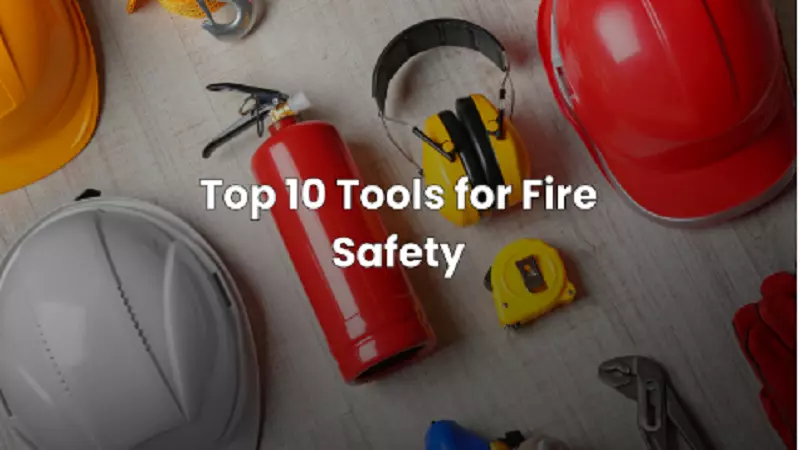Preparation is the key to surviving a fire. Rapidly starting and spreading fires are a constant threat that may quickly cause widespread devastation. For this reason, having access to adequate equipment is crucial for ensuring people’s and property’s safety. Access to the best fire safety equipment is vital whether you’re a homeowner, company owner, or just someone who cares about the safety of people around you. We’ll review the ten most crucial items in case of a fire, emphasizing the value of Fire Safety Training and Fire Safety Awareness.
Table of contents
- The Importance of Fire Safety Education and Awareness Training
- Smoke Alarms
- Fire Blankets
- Fire Hose Reels
- Fire Escape Ladders
- Fire Sprinkler Systems
- Fireproof Safes
- Fire-Resistant Clothing
- Fire Safety Signage
- Fire Safety Apps and Technology
- The Importance of Regular Maintenance
- Conclusion
The Importance of Fire Safety Education and Awareness Training
Before diving into the actual tools, fire safety education and awareness should be grasped. Effective fire safety procedures are predicated on these two factors.
Training in fire safety equips people with the know-how to avoid hazards, deal with crises, and make the most of firefighting equipment. This education is crucial in both private and public spheres.
However, Fire Safety Awareness seeks to instill a culture of awareness and readiness. It inspires individuals to be watchful for possible fire threats and to take preventative measures against them. Awareness of fire hazards may reduce the likelihood of fires, which saves lives.
Let’s look at the top 10 fire safety equipment items right now.
Fire Extinguishers
In the early phases of a fire, fire extinguishers are crucial equipment. Different varieties are aimed towards different kinds of fires.
- Standard combustibles may be put out using a Class A extinguisher.
- Fires caused by combustible substances like petrol and oil need a Class B extinguisher.
- Fires involving electricity need a Class C extinguisher.
- Fires involving flammable metals require the use of a Class D extinguisher.
- Class K extinguishers are designed for grease and oil fires in the kitchen.
Learning how to use an extinguisher and what kind to use in various situations is an important part of fire safety training.
Smoke Alarms
Alarms that detect smoke, a typical prelude to fires, serve as an early warning system. They’re vital because they give people a heads-up to safely exit the building. To ensure the alarms are working properly, they must be tested regularly and the batteries replaced once a year.
Fire Blankets
You may use a fire blanket to smother a minor fire or to protect yourself from the flames while you escape a larger blaze. A stovetop and kitchen fires may be rapidly put out with their help since they are often composed of fireproof materials.
Fire Hose Reels
Fire hose reels are vital for extinguishing fires in big commercial or industrial buildings. They may keep a fire from spreading until firefighters arrive by spraying it with a steady, forceful jet of water. Safe use of fire hose reels and successful fire management need proper training for those involved.
Fire Escape Ladders
A fire escape ladder is a crucial piece of equipment for any structure or residence with more than one story. When standard exits are blocked, they may be fastened to windows or balconies to provide a safe alternative. Rapid and orderly egress relies on properly deploying these systems, which may be practiced during fire drills.
Fire Sprinkler Systems
When it comes to extinguishing fires in buildings (both commercial and residential), automatic fire sprinkler systems are unparalleled. Sprinkler heads, water pipelines, and water supply tanks make up these systems, which turn on at a certain temperature. They spray water on the flames to put them out, which saves lives and protects property.
Fireproof Safes
In the case of a fire, heat, and smoke may quickly damage paper records, valuables, and digital materials such as hard drives. Fireproof safes are constructed to endure high temperatures without compromising the security of their contents. Passports, birth certificates, insurance policies, and precious artifacts are some important documents that may be protected in homes and companies.
Fire-Resistant Clothing
There is a larger likelihood of flames and excessive temperatures for workers in certain fields. Wearing protective gear like flame-resistant coveralls, gloves, and helmets while working in or around fires is crucial. Self-extinguishing flame technology built into these clothing helps keep workers safer in high-risk situations.
Fire Safety Signage
Fire safety signage is integral to fire prevention in buildings and other public areas. Fire safety equipment, such as fire extinguishers and fire alarm pull stations, and the exits they lead should be marked with appropriate signage. Signage that is visible and understandable in times of crisis might be the difference between order and confusion.
Fire Safety Apps and Technology
Fire prevention has benefited much from modern technologies as well. Real-time data about fire incidences, evacuation routes, and surrounding safety facilities may be accessed through mobile applications and other technological advancements in fire safety. In an emergency, these resources aid in swiftly locating the closest escape, haven, or emergency contact information so that people may respond accordingly. Fire safety rules and advice are commonly included in mobile applications, making them useful for prevention and response.
The Importance of Regular Maintenance
Having access to these resources is just half the battle. To guarantee the reliability of these items in an emergency, they must be regularly serviced and inspected. Regular inspections of fire extinguishers, smoke detectors, and other safety devices are emphasized in fire safety education.
Conclusion
Individuals and groups alike must work together to ensure the safety of their communities in the event of a fire. The first step is fire safety education, which provides people with the skills they need to act responsibly in the event of a fire. In addition, raising people’s awareness of fire safety helps guarantee that preventative actions are implemented to avoid fires.

